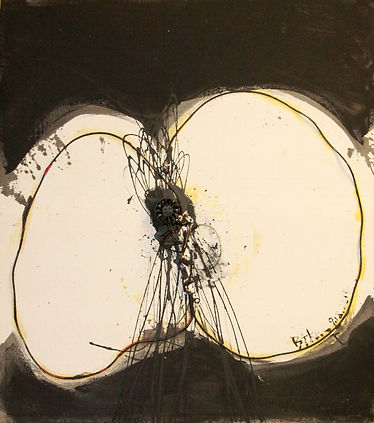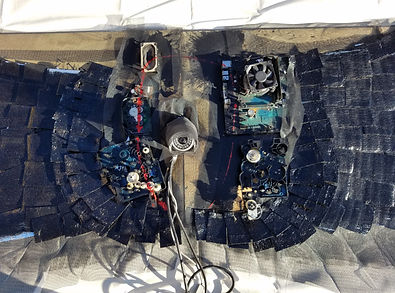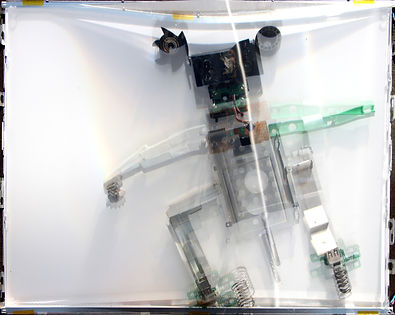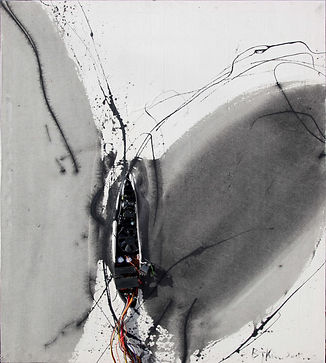Artist Bong Jung Kim
"Through a life shaped by hardship, resilience, and unwavering dedication, Bong Jung Kim transforms discarded materials into powerful, symbolic depictions of the female body - celebrating rebirth, harmony, and the human capacity for renewal."
Interview By Paris Koh
1. Please introduce yourself and share your background as an artist.
I was born in 1962 in Seoul, Korea, and graduated from the Department of Western Painting at Seoul National University. I moved to the U.S. and currently live in Dumont, New Jersey,
oup shows. Currently, I’m part of a three-person group exhibition titled "Reclaiming The Invisible" at Paris Koh Fine Arts in Fort Lee.
My journey into art began during childhood, growing up in poverty. The only accessible joy I had was visiting comic book rental shops, where I started copying comics and discovered the pleasure of drawing. In elementary school, my neighborhood in Hannam-dong was demolished and landfilled with trash. I collected discarded wires and scrap metal, which I later sold to scrap dealers to buy comic books. That early experience profoundly influenced my later work using found objects.
In middle school, I found all subjects boring except art. I nearly failed out, with grades so poor I couldn't get into any high school. I gave up on continuing education and got a job as a janitor and errand boy at the electron microscope lab in the Seoul National University Medical School. While working there for five years, I enrolled in night school and eventually graduated high school. During this time, I experienced a major turning point.
One day, I saw a stunningly beautiful female medical student entering the campus art club. Captivated, I later asked to join and did my first plaster cast drawing. (Looking back, I wonder if she appeared so radiant because a divine light shone on her.) Not long after, I joined a local art studio where I met my lifelong mentor, Mr. Ilman Cha. Though I couldn’t afford lessons on a janitor’s salary, he allowed me to study under him. After a year of intense study in drawing and watercolor, I was accepted into Seoul National University’s art school. It felt like a dream—one day a janitor, the next a fine arts student (class of '84, ID 8408-1108). I was so overjoyed to be at art school that I painted every day until the security guard told me to leave. I didn’t want to waste the life I had been given. But I didn’t prepare for the future beyond painting in the studio.
After graduating, my life took a sharp turn. I immigrated to the U.S. with my family and had to start over from scratch. I waited tables, moved between countless jobs, even sold goods out of a van. Despite the harsh realities of immigrant life, I never gave up on painting. Even when getting fired and rehired repeatedly, I clung to my belief that art was my calling. (Though I now have a stable job,) for many years, I had no choice but to endure an unstable life. Even today, I work full-time to support my family, but every night, I paint for two hours in my garage. It’s been 35 years of that routine.
Mixed%20Media%20on%20Monitor%20year2018_edited.jpg)
Mixed%20Media%20on%20Monitor%20year2018.jpg)
AI Robot 2, 14 x 14 in. Mixed Media on Monitor, 2018
AI Robot 17, 12.5 x 16.5 in. Mixed Media on Monitor, 2018
2. What themes or messages do you aim to convey through your work?
I primarily use discarded materials to depict the female body. The female body symbolizes fertility and creation, while the canvas itself becomes a metaphor for the female form. When these abandoned objects are reassembled on the canvas, they are reborn as works of art—transformed into creations that carry new meaning and value.
This act of reclamation gives the materials a second chance at existence, and in doing so, my work speaks to the transformative power of creativity. By collecting and repurposing discarded items, I emphasize the human capacity for change and innovation.
Ultimately, my work is a celebration of hope and regeneration. It reminds us that even what has been thrown away holds the potential for new beginnings. This message resonates strongly in the context of building a more sustainable and humane society.
3. Can you describe your creative process, from initial concept to finished piece?
My ideas often originate from everyday experiences, particularly the dissonance and tension found in human relationships. I reflect deeply on the contradictions we encounter in life and jot down these thoughts in my notebook. I also look inward—exploring my own emotional states, my attachments, and the existential questions that arise.
From these journal entries and sketches, I select one idea to develop further. Once I've gathered the necessary materials and constructed the canvas and frame, I immerse myself fully in the work. After completing the piece, I document it through photography and organize the materials and notes, bringing the process to a close.
.jpg)
.jpg)
Addiction, 44x39 in. mixed media on Canvas, 2018
Addiction 214, 41x41 in. mixed media on Canvas, 2016
4. What inspires your work? How does your environment influence your creative process?
Two types of inspiration guide my practice: spontaneous and intentional reflections on the female body. These thoughts, both sudden and contemplative, profoundly influence my artistic vision.
I believe this longing for the female form—an emblem of creation—has been within me since infancy. The female body, capable of bearing life, is a subject of immense reverence.
However, my current environment often makes it difficult to fully explore this theme. Raised within both Confucian traditions and Christian values, I have internalized social taboos regarding representations of the female form. Although I sometimes hesitate to share such works, I address this complexity through the theme of “harmony.”
In my view, if disparate materials can coexist harmoniously on a single canvas, perhaps human beings—despite our differences—can also coexist within the greater canvas of existence. In this way, the female body in my work symbolizes a space of rebirth and coexistence.
5. What challenges have you faced as an artist, and how have you overcome them?
Because my work appeals to a niche audience, it’s difficult to support myself solely through art. I often have to spend time doing unrelated work to cover living expenses. As a result, I’ve adapted my process to accommodate limited time—creating works that can be completed efficiently without compromising artistic integrity.
.jpg)
.jpg)
Addiction Installation, Mixed Media, 2016
Addiction 272, 24x48 in. Mixed media, 2016
6. Do you feel your identity as an Asian artist affects your work?
I haven’t had many experiences within mainstream art spaces, so I’m not entirely sure how my identity as an Asian artist affects my reception. However, I do feel tension between my bold, unfiltered expressions and the conservative atmosphere of the Asian and religious communities I’m part of. These tensions sometimes cause hesitation, especially when dealing with themes related to the female body.
7. What does your daily routine look like? Are there any habits or practices essential to your creativity?
I wake up at 6:30 AM, shower, prepare breakfast, and head to work by 8:45 AM. Throughout the workday, I jot down ideas or sketches whenever inspiration strikes.
After work, I organize these thoughts and sketches. From 7:30 PM to 10:00 PM, I work in my garage studio. This routine—especially the daily reflection and studio time—is essential to my creative process.
8. Are there any current works-in-progress or upcoming exhibitions you’d like to share?
I’m currently working on a new series exploring the female nude through collage and semi-abstract compositions under the theme of Harmony.
Right now, I'm participating in a three-person group show titled Reclaiming the Invisible at Paris Koh Fine Arts in Fort Lee, NJ. In early September, I will be presenting a solo exhibition at GALA Arts Center in College Point, Queens, New York.
-2018.jpg)
1. 자기 소개 와 작가 로서 의 배경 에 대해 말씀해 주세요.
저는 1962년 서울 에서 태어나 서울대 미술대학 서양화과 를 졸업하고 미국으로 건너 와 현재 뉴저지주 듀몬트 에 살면서 작품활동을 하고 있다. 그 동안 13번의 개인전과 20여차례 가까운 그룹 전 에 참가했고, 현제 는 포트리 에 있는 Paris Koh Fine Art's Gallery에서 "Reclaiming The Invisible" 주제 로 3인 그룹전 에 참여 하고 있습니다.
제가 미술에 입문 하게 된 계기 는 어릴때 가난한 환경속에서 쉽게 접 하고 즐길 수있는 것 이 만화방에 가는 일이였었고. 여기서 부터 자연스럽게 만화 를 따라 그리면서 그리는 것 에 대한 즐거움을 알게되었습니다. 초등학교때 살던 한남동 동네 가 철거 되고 각종 쓰레기 로 골짜기 동네 를 매립할때 버려진 쓰레기 더미 속에서 전깃줄 이나 그밖에 고철들을 모았다.(이것 은 먼훗날 지금 의 저의 작업 에 자주 사용 되어지는 버려진 오브제 를 사용 하는 작업 에 큰 영향 을끼치 는 일이되었다) 이것 을 고철가게 에 같다 주고 몇 십원을받으면 만화 가게 로 달려 가곤했다. 나는 그 때 만화 를 보는것이 무척 즐 거운 일이였었고 부지런히 보고 주인공 을 따라 그렸는데 그러면서 그림 에 눈을 뜨지않았나 생각 한다.”
중학교 에 가서는 그림 외에 다른 공부 들은 너무 지루했다. 그저 미술 시간이 있는 날만 기다리곤했 다. 공부 는 중학교 졸업할 때 갈만한 고등 학교 가 없을 정도 로 거의 낙제 였다. 결국 나는 고교 진학 을 포기 하고 형의 친구 소개 로 지금 의 서울 연건동 에 있는 서울대 의과대학 전자현미경 실험실 에 청소 와 잔 심부름 을 하는 사환 으로 취직 한다. 그 곳에서 5년동안 지내면서 야간 고등학교 에 진학해 졸업하고, 2년정도 대입을 위해 재수하는 동안 인생 의 전환 점이 되는 사건 을 경험 했다.
“한번은 사환으로 일 할 당시 정말 눈이 부실 정도 로 아름다운 의대 여학생이 의과대학 캠퍼스 안에 있는 미술 동아리실로 들어가는 것을 보고 며칠 후 그곳 미술반 서클 학생들에게 부탁해 처음 으로 미술 의 기본인 석고 데생 을 하게 됐다.(아마도 그 여학생이 그렇게 그순간 눈부시게 나의 눈을 사로잡은게 아마도 천사가 그녀위에 빛 으로 임한 것 이 아닌 지 생각 해본다.)그리고 얼마 후 근처에 있던 화실에 들어가 그 곳에서 저의 평생 의 은인 이신 차일만 선생님을 뵙게 됐다. 당시 사환 이 받는 급료 로는 미술 레슨비에 턱없이 부족했지만 차 선생님 배려로 공부를 할 수 있었다. 그곳에서 1년간 집중적으로 데생과 수채화를 배운 후 그 해 겨울 서울대 미대에 합격을 했다. 정말 그 때 당시에는 이것이 꿈인지 현실인지. 나에겐 어제와 오늘이 너무 다른 세상이었다.”
어제까지는 청소부 사환이었고 오늘은 서울대 미대 서양화과(학번 8408-1108) 학생이라는 엄청난 변화를 느끼며 대학생활 4년 내내 정말 학교에서 미친 듯이 그림에 몰두했다. 거의 매일 학교 수위 아저씨가 그만 집에 가라 할 때까지 실습실에서 그림을 그릴 정도로 대학생활이 너무 기쁘고 즐거웠다. 나에게 찾아 온 삶을 그냥 놓칠 수가 없었다. 그러나 문제는 그 때 실기실에서 그림 그리는 것 외에는 미래에 대한 아무런 준비를 하지 않았다는 것이다.
결국 나의 인생은 급하게 바뀐다. 서울대를 졸업한 뒤 얼마 지나지 않아 가족초청으로 이민을 오게 됐고, 그 이후의 삶은 그야말로 다시 저 밑바닥서 시작해야 했다. 식당에서 손님 시중을 드는 일을 하기도 했고. 수많은 직장을 옮겨 다녔다. 어떤 때는 작은 차에 물건을 싣고 무작정 물건을 팔기 위해 각지를 누비기도 했다. 각박한 이민 생활 속에서 그림에 대한 꿈을 놓지 않은결과는 참담하게도. 1년에도 몇 번씩 직장에서 쫓겨나고, 다시 들어가고, 옮겨 다니는 생활을 반복하면서도 늘 나의 업이 그림을 그리는 것이라고 생각해 붓을 놓지 않았다. (지금은 안정된 직장생활을 하게되었지만) 이 전까지는 그러한 불안한 삶 을지속 할수밖에 없었고 지금도 여전이 풀타임으로 가족의 생계를 위해 일하고 있지만 저녁에는 2시간 정도씩 결코 포기할 수 없는 꿈을 위해 집 차고에서 그림을 그린다. 그러기를 벌써 세월이 35년이 흘렀다.
2. 작품을 통해 전달하고자 하는 주제나 메시지는 무엇인가요?
나는 주로 버려진 물건들을 선택하여, 여인의 몸을 표현합니다.
여인의 몸은 생명을 잉태함을 상징하고 캔버스는 여인의 몸을 상징하고 버려진것들이 캔바스위에서 조화를 이뤄 예술작품으로 다시 태어날때 예전에 버려진 그 물질들은 캔버스 안에서 완전히 다른 가치를 지닌 창조물로 태어나게됨을 보여줍니다.
그것들이 새로운 캔바스 작품 속에서 다시 태어나는 과정은 그들에게 새로운 존재의 기회를 제공합니다.
나의 작업은 또한 버려진 물건들을 수집하고 재활용하여 새로운 작품을 만드는 과정이 인간의 창의력과 변화력을 강조한다고 생각합니다.
이러한 작업은 우리가 살아가는 세계를 더욱 아름답게 만들기 위한 우리의 노력을 상징합니다.
마지막으로, 나의 작품은 사람들에게 희망과 재생의 메시지를 전달합니다. 버려진 것들도 새로운 가능성을 품고 있으며, 우리는 이를 통해 새로운 시작과 미래를 창조할 수 있다는 것을 기억해야 합니다.
이는 우리가 지속 가능한 사회를 구축하기 위해 노력할 때 무한한 희망을 가져다 줍니다.
-2018.jpg)
3. 새로운 작품을 시작할 때 아이디어 구상부터 완성까지 어떤 과정을 거치시나요?
사람들과의 만남속에서 부딧치고 고민하게되는 인간관계의 부조화의 생활속에서 경험하게되는 생각들과 인간들은 왜 이럴수밖에 없는지 의문을 갖고 이해하는 과정을 노트에 메모하고 작품으로 발전하게된다. 아울러 내자신도 나의 내면의 상태를 들여다보고 지금 나는 왜 무엇에 집착하고 있는지를 메모하고 그로부터 고민하게되는 사고의 흐름을 따라가다보면 왜라는 물음에 도달하게된다. 메모되어진 그날들의 아이디어 스케치중 하나를 정해서 캔바스에서 다시 작업합니다. 작업전에는 작업에 필요한 자료들과 재료들 캔바스와 액자까지 제작하여 모든 준비를 맞친후 비로서 작업에 올인하게 됩니다. 작업이 끝난후에 촬영하고 자료들을 정리하면 하나의 작품이 마무리가 된다.

4. 작품에 영감을 주는 것은 무엇인가요? 또, 주변 환경은 창작 과정에 어떤 영향을 미치나요?
두가지로 말한다면 첫째는 불현듯 찾아오는 여인의 육체에대한 생각들이있고 둘째도 의도적으로 사유하는 여인의 육체에대한 생각들입니다.
두가지다 저의 작업에 지대한 영향을 미치고 있습니다.
여체를 갈망하는 저의 마음은 아주 오래전 갓난 아기때부터 이미 내 안에 존재해 있는 느낌 이 아닐까 생각합니다.
생명을 잉태하는 여인의 몸은 경의로움 그 자체 입니다. 지금 의 나의 환경 은 이러한 여인의 몸에 대한 작업 을 주저 하게 하곤합니다.
이유는 이미 뼛속까지 깃들여있고 형성되어져 있는 아시안인의 유교적 전통과 또하나는 태어나고 자라나면서 새로이 접하게된 기독교적인 삶에 익속해져있는 환경이 여인의 몸에대해서 암묵적으로 금기시되는 환경이고 그러한 주변의 시선에서 결코 자유스러울수 없기 때문에 때때로 여인을 주제로한 나의 작품를 발표하는데 맣은 주저함이 있지만, "조화"라는 주제를 통해서 여인의 몸이 나의 작품에 어떤 상징을 말하는지 보여줄수있습니다. 그것은 서로다른 이질적인 물질들이 하나의 판 위에서 조화를 이룰수있다면 우리 인간들도 그분의 작품속에서 어우러질수 있지 않을까 하는 것처럼, 여인의 몸은 그분의 캔바스이고 그 안에서 서로다른 이질적인 것들이 조화를 이뤄 다시 잉태하고 태어나게하는 여인의 몸을 상징합니다.
5. 작가로서 겪은 어려움이 있다면 무엇이고, 그것을 어떻게 극복하셨나요?
나의 작품은 소수의 사람들만 관심을 가지기때문에 작품을 팔아 생활하기는 쉽지않다.
생활비를 벌기위해 많은시간을 그림과는 무관한 일에 시간을 소모케되므로 대부분 저의 작업은 짦은 시간안에 만들수있는 작업스타일로 부족한 시간의 어려움을 극복케됩니다.
6. 아시아인으로서의 정체성이 작품에 영향을 미친다고 생각하시나요, 아니면 무관하다고 보시나요?
아직 주류쪽에서 활동한 경험이 별로없어서 내가 아시안이라는것이 이곳에서 얼마만큼의 불편함을 가져다주는지 알수없습니다. 하지만 내가 생각하고 만드는 과감하고 노골적인 표현의 작업들이 아시안 커뮤니티의 보수적인 환경과 종교안에서 때때로 부딧치고 주저하게됨을 느끼곤합니다.
7. 작가로서의 일상 루틴을 말씀해 주세요. 창작 과정 에서 중요한 습관이나 실천이 있다면요?
아침에 6시30분에 일어나면 샤워하고 아침을 만들어먹고 8시 45분까지 일터로 출근합니다.일터에서 일하면서 틈틈히 작품 에 대한 구상 과 아이디어 스케치 를 합니다. 중요한 습관은 퇴근후 그날 떠오른 아이디어들을 정리해서 매일저녁 식사후 7시30분부터 10시까지 차고에서 작업을 합니다.
8. 현재 작업 중인 작품이나 프로젝트, 예정된 전시가 있다면 소개해 주세요.
하모니란 주제로 여인의 누드를 꼴라쥬형식을 빌려서 반추상느낌으로 표현하는 작품을 만들고 있습니다.
현제 포트리에있는 Paris Koh Fine Art's Gallery에서 "Reclaiming The Invisible" 주제로 3인 그룹전에 참여하고 있습니다.
올 9월초에는 뉴욕 퀸즈 컬리지포인트에 있는 GALA Arts Center 에서 개인전이 기획되어 있습니다.

Chief Editor Paris Koh
